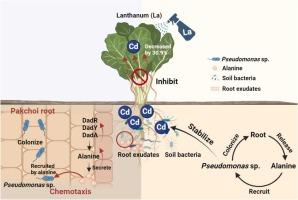Chemotaxis of rhizosphere Pseudomonas sp. induced by foliar spraying of lanthanum reduces cadmium uptake by pakchoi
IF 12.2
1区 环境科学与生态学
Q1 ENGINEERING, ENVIRONMENTAL
引用次数: 0
Abstract
Foliar application of rare earth micronutrient of lanthanum (La) exhibits great potential in reducing cadmium (Cd) uptake in crops, the underlying mechanisms controlling the interaction between Cd toxicity-relieved crops and soil microbiota are poorly understood. In this study, LaCl3 with the concentrations of 10 and 30 μM was sprayed on pakchoi (Brassica chinensis L.) planting on Cd contaminated solution and soil to determine the changes of root metabolites and rhizosphere bacterial communities. Compared to the control, Cd concentration in pakchoi leaves was significantly decreased by 30.9 % and 22.6 % with the high group under both hydroponic and pot culture by applying 30 μM LaCl3. Herein, the concrete evidence is provided that pakchoi plants in response to foliar-spraying La under soil or solution Cd toxicity can promote the root secretion of amino acids, resulting in a strong enrichment of nitrogen-related microorganisms. To probe this linkage, a Pseudomonas representative specie was isolated that had the ability of consuming alanine, the most oversecreted root exudate due to La application. Further results demonstrated that this strain had the capacities for alleviating Cd toxicity and enhancing crop growth by immobilizing Cd and secreting plant-beneficial metabolites. This study reveals a plant-extrudate-microbiome feedback loop for responding to La-relieved Cd toxicity in crops by the chemotaxis of rhizosphere Pseudomonas toward alanine secreted by pakchoi.

叶面喷洒镧诱导根瘤假单胞菌的趋化作用可减少百草对镉的吸收
稀土微量营养元素镧(La)的叶面喷施在减少作物对镉(Cd)的吸收方面具有巨大潜力,但人们对控制镉解毒作物与土壤微生物区系之间相互作用的内在机制知之甚少。本研究将浓度分别为 10 和 30 μM 的 LaCl3 喷洒在受 Cd 污染的溶液和土壤中种植的白菜上,以测定根系代谢产物和根圈细菌群落的变化。与对照组相比,在水培和盆栽条件下,施用 30 μM LaCl3 后,白菜叶片中的镉浓度分别显著降低了 30.9% 和 22.6%,高浓度组降低了 22.6%。本文提供的具体证据表明,在土壤或溶液镉毒性条件下,白花蛇舌草对叶面喷施 La 的反应可促进根部分泌氨基酸,从而导致氮相关微生物的大量富集。为了探究这种联系,研究人员分离出了一种假单胞菌代表菌株,该菌株具有消耗丙氨酸的能力,而丙氨酸是施用 La 后根部渗出物分泌最多的物质。进一步的研究结果表明,该菌株具有减轻镉毒性的能力,并能通过固定镉和分泌对植物有益的代谢物来促进作物生长。这项研究揭示了植物-外渗出物-微生物组的反馈回路,通过根瘤假单胞菌对白茅分泌的丙氨酸的趋化作用,对La缓解的作物镉毒性做出反应。
本文章由计算机程序翻译,如有差异,请以英文原文为准。
求助全文
约1分钟内获得全文
求助全文
来源期刊

Journal of Hazardous Materials
工程技术-工程:环境
CiteScore
25.40
自引率
5.90%
发文量
3059
审稿时长
58 days
期刊介绍:
The Journal of Hazardous Materials serves as a global platform for promoting cutting-edge research in the field of Environmental Science and Engineering. Our publication features a wide range of articles, including full-length research papers, review articles, and perspectives, with the aim of enhancing our understanding of the dangers and risks associated with various materials concerning public health and the environment. It is important to note that the term "environmental contaminants" refers specifically to substances that pose hazardous effects through contamination, while excluding those that do not have such impacts on the environment or human health. Moreover, we emphasize the distinction between wastes and hazardous materials in order to provide further clarity on the scope of the journal. We have a keen interest in exploring specific compounds and microbial agents that have adverse effects on the environment.
 求助内容:
求助内容: 应助结果提醒方式:
应助结果提醒方式:


